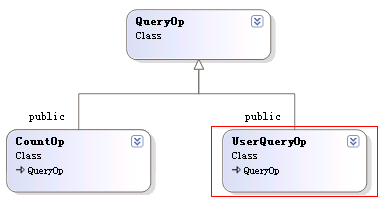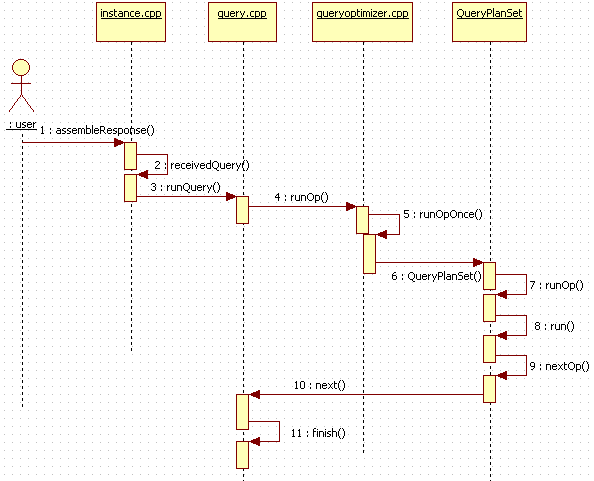在这个系列的开头几篇文章中,曾经介绍了Mongodb的查询流程,因为篇幅所限,并未介绍对cursor进行遍历查询时,如何将查询记录装填进结果集中。
今天就针对诸如 select top n 这类返回一定数量记录的查询操作,来分析mongodb是如何将查询结果装填到结果集中的。这里要说明的是 之前文章 中的大部分程序流程,在select top 这类操作也都是要执行的,所以这里接着之前文章所说的内容,继续向底层挖掘相应的功能逻辑。
今天就针对诸如 select top n 这类返回一定数量记录的查询操作,来分析mongodb是如何将查询结果装填到结果集中的。这里要说明的是 之前文章 中的大部分程序流程,在select top 这类操作也都是要执行的,所以这里接着之前文章所说的内容,继续向底层挖掘相应的功能逻辑。
之前查询流程中介绍过QueryPlanSet::Runner::run()方法,它本身为struct类型,主要是用于对执行步骤进行封装(形成依次执行的操作流),如下(详情见注释):
//
queryoptimizer.cpp
shared_ptr < QueryOp > QueryPlanSet::Runner::run() {
......
// 遍历查询操作集合,找到已执行完成的操作
for ( vector < shared_ptr < QueryOp > > ::iterator i = ops.begin(); i != ops.end(); ++ i ) {
initOp( ** i );
if ( ( * i) -> complete() )
return * i;
}
// 将查询操作集合转换成查询队列
std::priority_queue < OpHolder > queue;
for ( vector < shared_ptr < QueryOp > > ::iterator i = ops.begin(); i != ops.end(); ++ i ) {
if ( ! ( * i) -> error() ) {
queue.push( * i );
}
}
while ( ! queue.empty() ) {
mayYield( ops );
// 找出队首的查询操作
OpHolder holder = queue.top();
queue.pop();
QueryOp & op = * holder._op;
// 执行下一操作,如果是userqueryop类型,则会执行query.cpp中的next()方法(位于734行)
// 该方法会最终将查询结果绑定到response message中(注:通过调用finish方法)
nextOp( op );
if ( op.complete() ) { // 如执行完成
if ( _plans._mayRecordPlan && op.mayRecordPlan() ) {
op.qp().registerSelf( op.nscanned() );
}
return holder._op;
}
if ( op.error() ) {
continue ;
}
queue.push( holder ); // 如未执行完成,再次该查询操作入队(尾)
// 使用查询计划?
if ( ! _plans._bestGuessOnly && _plans._usingPrerecordedPlan && op.nscanned() > _plans._oldNScanned * 10 && _plans._special.empty() ) {
holder._offset = - opnscanned();
_plans.addOtherPlans( true );
PlanSet::iterator i = _plans._plans.begin();
++ i;
for ( ; i != _plans._plans.end(); ++ i ) {
shared_ptr < QueryOp > op( _op.createChild() );
op -> setQueryPlan( i -> get () );
ops.push_back( op );
initOp( * op );
if ( op -> complete() )
return op;
queue.push( op );
}
_plans._mayRecordPlan = true ;
_plans._usingPrerecordedPlan = false ;
}
}
return ops[ 0 ];
}
void QueryPlanSet::Runner::nextOp( QueryOp & op ) {
GUARD_OP_EXCEPTION( op, if ( ! op.error() ) { op.next(); } );
}
shared_ptr < QueryOp > QueryPlanSet::Runner::run() {
......
// 遍历查询操作集合,找到已执行完成的操作
for ( vector < shared_ptr < QueryOp > > ::iterator i = ops.begin(); i != ops.end(); ++ i ) {
initOp( ** i );
if ( ( * i) -> complete() )
return * i;
}
// 将查询操作集合转换成查询队列
std::priority_queue < OpHolder > queue;
for ( vector < shared_ptr < QueryOp > > ::iterator i = ops.begin(); i != ops.end(); ++ i ) {
if ( ! ( * i) -> error() ) {
queue.push( * i );
}
}
while ( ! queue.empty() ) {
mayYield( ops );
// 找出队首的查询操作
OpHolder holder = queue.top();
queue.pop();
QueryOp & op = * holder._op;
// 执行下一操作,如果是userqueryop类型,则会执行query.cpp中的next()方法(位于734行)
// 该方法会最终将查询结果绑定到response message中(注:通过调用finish方法)
nextOp( op );
if ( op.complete() ) { // 如执行完成
if ( _plans._mayRecordPlan && op.mayRecordPlan() ) {
op.qp().registerSelf( op.nscanned() );
}
return holder._op;
}
if ( op.error() ) {
continue ;
}
queue.push( holder ); // 如未执行完成,再次该查询操作入队(尾)
// 使用查询计划?
if ( ! _plans._bestGuessOnly && _plans._usingPrerecordedPlan && op.nscanned() > _plans._oldNScanned * 10 && _plans._special.empty() ) {
holder._offset = - opnscanned();
_plans.addOtherPlans( true );
PlanSet::iterator i = _plans._plans.begin();
++ i;
for ( ; i != _plans._plans.end(); ++ i ) {
shared_ptr < QueryOp > op( _op.createChild() );
op -> setQueryPlan( i -> get () );
ops.push_back( op );
initOp( * op );
if ( op -> complete() )
return op;
queue.push( op );
}
_plans._mayRecordPlan = true ;
_plans._usingPrerecordedPlan = false ;
}
}
return ops[ 0 ];
}
void QueryPlanSet::Runner::nextOp( QueryOp & op ) {
GUARD_OP_EXCEPTION( op, if ( ! op.error() ) { op.next(); } );
}
因为UserQueryOp是QueryOp的子类,如下图:

因为本文是UserQueryOp对象,则上面代码段中的nextOp()会最终调用该对象的next方法:
//
query.cpp
virtual void next() {
.....
if ( ! _c || ! _c -> ok() ) {
finish( false );
return ;
}
bool mayCreateCursor1 = _pq.wantMore() && ! _inMemSort && _pq.getNumToReturn() != 1 && useCursors;
if ( 0 ) {
cout << " SCANNING this: " << this << " key: " << _c -> currKey() << " obj: " << _c -> current() << endl;
}
// 判断是否超出扫描项限制,形如:db.foo.find()._addSpecial( "$maxScan" , 50 )
if ( _pq.getMaxScan() && _nscanned >= _pq.getMaxScan() ) {
finish( true ); // 直接返回
return ;
}
_nscanned = _c -> nscanned();
if ( ! matcher() -> matches(_c -> currKey(), _c -> currLoc() , & _details ) ) {
// 未匹配,则指向下一条记录
if ( _details.loadedObject )
_nscannedObjects ++ ; // 扫描对象累加1
}
else {
_nscannedObjects ++ ; // 扫描对象累加1
DiskLoc cl = _c -> currLoc();
// 当前是否使用shard分片,且是否在当前shard chunk中
if ( _chunkManager && ! _chunkManager -> belongsToMe( cl.obj() ) ) {
_nChunkSkips ++ ;
// log() << "TEMP skipping un-owned chunk: " << _c->current() << endl;
}
else if ( _c -> getsetdup(cl) ) { // 值是否重复
// dup
}
else {
// 如匹配
if ( _inMemSort ) { // 当使用scanAndOrder
// note: no cursors for non-indexed, ordered results. results must be fairly small.
_so -> add( _pq.returnKey() ? _c -> currKey() : _c -> current(), _pq.showDiskLoc() ? & cl : 0 );
}
else if ( _ntoskip > 0 ) {
_ntoskip -- ;
}
else {
if ( _pq.isExplain() ) { // 如果使用explain指令(用于显示如何执行当前指令)
_n ++ ;
if ( n() >= _pq.getNumToReturn() && ! _pq.wantMore() ) {
// .limit() was used, show just that much.
finish( true );
return ;
}
}
else {
if ( _pq.returnKey() ) {
BSONObjBuilder bb( _buf );
bb.appendKeys( _c -> indexKeyPattern() , _c -> currKey() );
bb.done();
}
else if ( _keyFieldsOnly ) {
fillQueryResultFromObj( _buf , 0 , _keyFieldsOnly -> hydrate( _c -> currKey() ) );
}
else {
BSONObj js = _c -> current();
assert( js.isValid() );
if ( _oplogReplay ) {
BSONElement e = js[ " ts " ];
if ( e.type() == Date || e.type() == Timestamp )
_slaveReadTill = e._opTime();
}
// 将当前记录填充到_buf中,以便finish方法使用该对象
fillQueryResultFromObj( _buf , _pq.getFields() , js , (_pq.showDiskLoc() ? & cl : 0 ));
}
_n ++ ;
if ( ! _c -> supportGetMore() ) {
if ( _pq.enough( n() ) || _buf.len() >= MaxBytesToReturnToClientAtOnce ) {
finish( true );
return ;
}
}
// 判断是否已够返回一批数据
else if ( _pq.enoughForFirstBatch( n() , _buf.len() ) ) {
/* if only 1 requested, no cursor saved for efficiency...we assume it is findOne() */
if ( mayCreateCursor1 ) {
_wouldSaveClientCursor = true ;
if ( _c -> advance() ) {
// more...so save a cursor
_saveClientCursor = true ;
}
}
// 查询结束,绑定查询结果数据到response
finish( true );
return ;
}
}
}
}
}
// 将游标指向下一条记录,该方法参见
// http://www.cnblogs.com/daizhj/archive/2011/04/15/mongodb_cursor_source_code.html
_c -> advance();
}
virtual void next() {
.....
if ( ! _c || ! _c -> ok() ) {
finish( false );
return ;
}
bool mayCreateCursor1 = _pq.wantMore() && ! _inMemSort && _pq.getNumToReturn() != 1 && useCursors;
if ( 0 ) {
cout << " SCANNING this: " << this << " key: " << _c -> currKey() << " obj: " << _c -> current() << endl;
}
// 判断是否超出扫描项限制,形如:db.foo.find()._addSpecial( "$maxScan" , 50 )
if ( _pq.getMaxScan() && _nscanned >= _pq.getMaxScan() ) {
finish( true ); // 直接返回
return ;
}
_nscanned = _c -> nscanned();
if ( ! matcher() -> matches(_c -> currKey(), _c -> currLoc() , & _details ) ) {
// 未匹配,则指向下一条记录
if ( _details.loadedObject )
_nscannedObjects ++ ; // 扫描对象累加1
}
else {
_nscannedObjects ++ ; // 扫描对象累加1
DiskLoc cl = _c -> currLoc();
// 当前是否使用shard分片,且是否在当前shard chunk中
if ( _chunkManager && ! _chunkManager -> belongsToMe( cl.obj() ) ) {
_nChunkSkips ++ ;
// log() << "TEMP skipping un-owned chunk: " << _c->current() << endl;
}
else if ( _c -> getsetdup(cl) ) { // 值是否重复
// dup
}
else {
// 如匹配
if ( _inMemSort ) { // 当使用scanAndOrder
// note: no cursors for non-indexed, ordered results. results must be fairly small.
_so -> add( _pq.returnKey() ? _c -> currKey() : _c -> current(), _pq.showDiskLoc() ? & cl : 0 );
}
else if ( _ntoskip > 0 ) {
_ntoskip -- ;
}
else {
if ( _pq.isExplain() ) { // 如果使用explain指令(用于显示如何执行当前指令)
_n ++ ;
if ( n() >= _pq.getNumToReturn() && ! _pq.wantMore() ) {
// .limit() was used, show just that much.
finish( true );
return ;
}
}
else {
if ( _pq.returnKey() ) {
BSONObjBuilder bb( _buf );
bb.appendKeys( _c -> indexKeyPattern() , _c -> currKey() );
bb.done();
}
else if ( _keyFieldsOnly ) {
fillQueryResultFromObj( _buf , 0 , _keyFieldsOnly -> hydrate( _c -> currKey() ) );
}
else {
BSONObj js = _c -> current();
assert( js.isValid() );
if ( _oplogReplay ) {
BSONElement e = js[ " ts " ];
if ( e.type() == Date || e.type() == Timestamp )
_slaveReadTill = e._opTime();
}
// 将当前记录填充到_buf中,以便finish方法使用该对象
fillQueryResultFromObj( _buf , _pq.getFields() , js , (_pq.showDiskLoc() ? & cl : 0 ));
}
_n ++ ;
if ( ! _c -> supportGetMore() ) {
if ( _pq.enough( n() ) || _buf.len() >= MaxBytesToReturnToClientAtOnce ) {
finish( true );
return ;
}
}
// 判断是否已够返回一批数据
else if ( _pq.enoughForFirstBatch( n() , _buf.len() ) ) {
/* if only 1 requested, no cursor saved for efficiency...we assume it is findOne() */
if ( mayCreateCursor1 ) {
_wouldSaveClientCursor = true ;
if ( _c -> advance() ) {
// more...so save a cursor
_saveClientCursor = true ;
}
}
// 查询结束,绑定查询结果数据到response
finish( true );
return ;
}
}
}
}
}
// 将游标指向下一条记录,该方法参见
// http://www.cnblogs.com/daizhj/archive/2011/04/15/mongodb_cursor_source_code.html
_c -> advance();
}
上面代码是实现了对相应cursor的遍历查询,找出(matches)合适的数据,并最后将结果添加到_buf对象中,之后再使用finish方法将_buf绑定到response中(向client发送信息),如下:
//
query.cpp
// this plan won, so set data for response broadly
void finish( bool stop ) {
if ( _pq.isExplain() ) {
_n = _inMemSort ? _so -> size() : _n;
}
// 当使用scanAndOrder(位于scanandorder.h),表示索引不能用于排序(sort)
else if ( _inMemSort ) {
if ( _so. get () )
_so -> fill( _buf, _pq.getFields() , _n );
}
if ( _c. get () ) {
_nscanned = _c -> nscanned();
// tailable设置
if ( _pq.hasOption( QueryOption_CursorTailable ) && _pq.getNumToReturn() != 1 )
_c -> setTailable();
// If the tailing request succeeded.
if ( _c -> tailable() )
_saveClientCursor = true ; // 是否保存ClientCursor
}
if ( _pq.isExplain() ) {
massert( 13638 , " client cursor dropped during explain query yield " , _c. get () );
_eb.noteScan( _c. get (), _nscanned, _nscannedObjects, _n, scanAndOrderRequired(),
_curop.elapsedMillis(), useHints && ! _pq.getHint().eoo(), _nYields ,
_nChunkSkips, _keyFieldsOnly. get () > 0 );
}
else {
if ( _buf.len() ) {
// 将_buf绑定到_response
_response.appendData( _buf.buf(), _buf.len() );
_buf.decouple();
}
}
if ( stop ) {
setStop(); /* 设置完成标志位"_complete"和_stopRequested
(用于MultiPlanScanner::runOp判断条件) */
}
else { // 设置完成标志位"_complete"
setComplete();
}
}
// this plan won, so set data for response broadly
void finish( bool stop ) {
if ( _pq.isExplain() ) {
_n = _inMemSort ? _so -> size() : _n;
}
// 当使用scanAndOrder(位于scanandorder.h),表示索引不能用于排序(sort)
else if ( _inMemSort ) {
if ( _so. get () )
_so -> fill( _buf, _pq.getFields() , _n );
}
if ( _c. get () ) {
_nscanned = _c -> nscanned();
// tailable设置
if ( _pq.hasOption( QueryOption_CursorTailable ) && _pq.getNumToReturn() != 1 )
_c -> setTailable();
// If the tailing request succeeded.
if ( _c -> tailable() )
_saveClientCursor = true ; // 是否保存ClientCursor
}
if ( _pq.isExplain() ) {
massert( 13638 , " client cursor dropped during explain query yield " , _c. get () );
_eb.noteScan( _c. get (), _nscanned, _nscannedObjects, _n, scanAndOrderRequired(),
_curop.elapsedMillis(), useHints && ! _pq.getHint().eoo(), _nYields ,
_nChunkSkips, _keyFieldsOnly. get () > 0 );
}
else {
if ( _buf.len() ) {
// 将_buf绑定到_response
_response.appendData( _buf.buf(), _buf.len() );
_buf.decouple();
}
}
if ( stop ) {
setStop(); /* 设置完成标志位"_complete"和_stopRequested
(用于MultiPlanScanner::runOp判断条件) */
}
else { // 设置完成标志位"_complete"
setComplete();
}
}
好了,今天的内容到这里就告一段落了,最后用一张时序图来总结一下查询(select top)在mongodb中的执行流程:

参考链接:
http://www.cnblogs.com/daizhj/archive/2011/03/18/1988288.html
http://www.cnblogs.com/daizhj/archive/2011/04/15/mongodb_cursor_source_code.html
原文链接:http://www.cnblogs.com/daizhj/archive/2011/05/05/2037717.html
作者: daizhj, 代震军
微博: http://t.sina.com.cn/daizhj
Tags: mongodb,c++






















 3799
3799

 被折叠的 条评论
为什么被折叠?
被折叠的 条评论
为什么被折叠?








